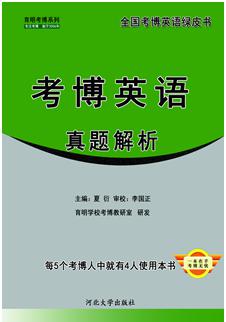资料来源:《考博英语真题解析》育明教育出品,北外夏衍教授主编
更多考博资讯、资料获取、考博课程QQ:547063862 电话:153-1148-1034
针对北京地区院校的考博开设的辅导课程包括:专业课小班课程·一对一课程·视频班·定向保录班·复试保过班。根植育明学校深厚的高校资源,整合利用历届育明优秀学员的成功经验与高分资料,为每一位学员构建考博成功的基础保障,辅导学员人数及辅导成绩连续多年稳居第一。



阅读理解:Passage 3
In recent years, there has been a steady assault on salt from the doctors: Salt is bad for you — regardless of your health. Politicians also got on board. "There is a direct relationship," US congressman Neal Smith noted, "between the amount of sodium a person consumes and heart disease, circulatory disorders, stroke and even early death."
Frightening, if true! But many doctors and medical researchers are now beginning to feel the salt scare has gone too far. "All this hue and cry about eating salt is unnecessary”, Dr. Dustan insists. "For most of us it probably doesn't make much difference how much salt we eat." Dustan's most recent short-term study of 150 people showed that those with normal blood pressure underwent no change at all when placed on an extremely low-salt diet, or later when salt was reintroduced. Of the hypertensive subjects, however, half of those on the low-salt diet did experience a drop in blood pressure, which returned to its previous level when salt was reintroduced.
"An adequate to somewhat excessive salt intake has probably saved many more lives than it has cost in the general population," notes Dr. John H. Laragh. "So a recommendation that the whole population should avoid salt makes no sense."
Medical experts agree that everyone should practice reasonable "moderation" in salt consumption. For an average person, a moderate amount might run from four to ten grams a day, or roughly 1/2 to 1/3 of a teaspoon. The equivalent or one to two grams of this salt allowance would come from the natural sodium in good. The rest would be added in processing, preparation or at the table.
Those with kidney, liver or heart problems may have to limit dietary salt, if their doctor advises. But even the very vocal "low salt" exponent, Dr. Arthur Hull Hayes, Jr. admits that "we do not know whether increased sodium consumption causes hypertension". In fact, there is increasing scientific evidence that other factors may be involved: deficiencies in calcium, potassium, perhaps magnesium; obesity (much more dangerous than sodium); generic predisposition; stress.
"It is not your enemy," says Dr. Laragh, "salt is the No.1 natural component of all human tissue, and the idea that you don't need it is wrong. Unless your doctor has proven that you have salt-related health problem, there is no reason to give it up.
39. According to some doctors and politicians, the amount of salt consumed ________.
A. exhibits as an aggravating factor to people in poor health
B. cures diseases such as stroke and circulatory disorders
C. correlates highly with some diseases
D. is irrelevant to people suffering from heart disease
40. From Dr. Dustan's study we can infer that ________.
A. a low-salt diet may be prescribed for some people
B. the amount of salt intake has nothing to do with one's blood pressure
C. the reduction of salt intake can cure a hypertensive patient
D. an extremely low-salt diet makes no difference to anyone
41. In the third paragraph, Dr. Laragh implies that ________.
A. people should not be afraid of taking excessive salt
B. doctors should not advise people to avoid salt
C. an adequate to excessive salt intake is recommended for people in disease
D. excessive salt intake has claimed some victims in the general population
42. What is the main message of this text?
A. The salt scare is not justified.
B. The origin of hypertension is now found.
C. The moderate use of salt is recommended.
D. Salt consumption is to be promoted.
Passage 4
Opinion polls are now beginning to show that, whoever is to blame and whatever happens from now on, high unemployment is probably here to stay. This means we shall have to make ways of sharing the available employment more widely.
But we need to go further. We must ask some primary questions about the future of work. Would we continue to treat employment as the norm? Would we not rather encourage many other ways for self-respecting people to work? Should we not create conditions in which many of us can work for ourselves, rather than for an employer? Should we not aim to revive the household and the neighborhood, as well as the factory and the office, as centers of production and work?
The industrial age has been the only period of human history in which most people's work has taken the form of jobs. The industrial age may now be coming to an end, and some of the changes in work patterns which it brought may have to be reversed. This seems a daunting thought. But, in fact, it could provide the prospect of a better future for work. Universal employment, as its history shows, has not meant economic freedom.
Employment became widespread when the enclosures of the 17th and 18th centuries made many people dependent on paid work by depriving them of the use of the land, and thus of the means to provide a living for themselves. Then the factory system destroyed the cottage industries and removed work from people's homes. Later, as transportation improved, first by rail and then by road, people commuted longer distances to their places of employment until, eventually, many people's work lost all connection with their home lives and the place in which they lived.
Meanwhile, employment put women at a disadvantage. In pre-industrial time, men and women had shared the productive work of the household and village community. Now it became customary for the husband to go out to paid employment, leaving the unpaid work of the home and family to his wife. Tax and benefit regulations still assume this norm today and restrict more flexible sharing of work roles between the sexes.
It was not only woman whose work status suffered. As employment became the dominant form of work, young people and old people were excluded — a problem now, as more teenager become frustrated at school and more retired people want to live active lives.
All this may now have to change. The time has certainly come to switch some effort and resources away from the idealist goal of creating jobs for all, to the urgent practical task of helping many people to manage without full time jobs.
43. Research carried out in the recent opinion polls shows that ________.
A. available employment should be restricted to a small percentage of the population
B. new jobs must be created in order to rectify high unemployment figures
C. available employment must be more widely distributed among the unemployed
D. the nowadays high unemployment figures are a truth of life
44. The arrival of the industrial age in our historical evolution meant that ________.
A. universal employment virtually guaranteed prosperity
B. economic freedom came within everyone's control
C. patterns of work were fundamentally changed
D. people's attitudes to work had to be reversed
45. The effects of almost universal employment were overwhelming in that ________.
A. the household add village community disappeared completely
B. men now traveled enormous distances to their places of work
C. the work status of those not in paid employment suffered
D. young and old people became superfluous components of society
46. The article concludes that ________.
A. the creation of jobs for all is an impossibility
B. our efforts and resources in terms of tackling unemployment are insufficient
C. people should begin supporting themselves by learning a practical skill
D. we should help those whose jobs are only part-time